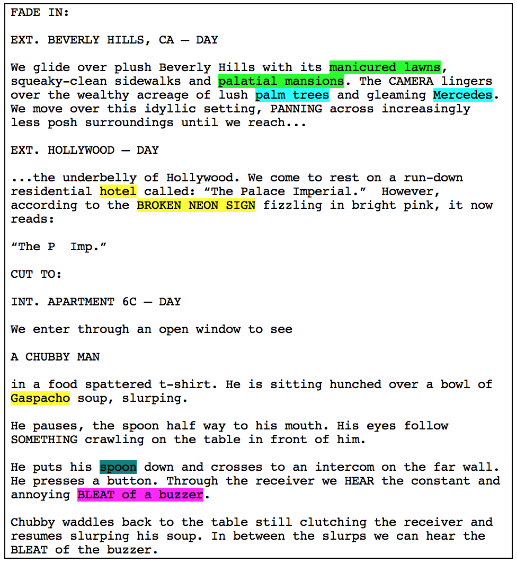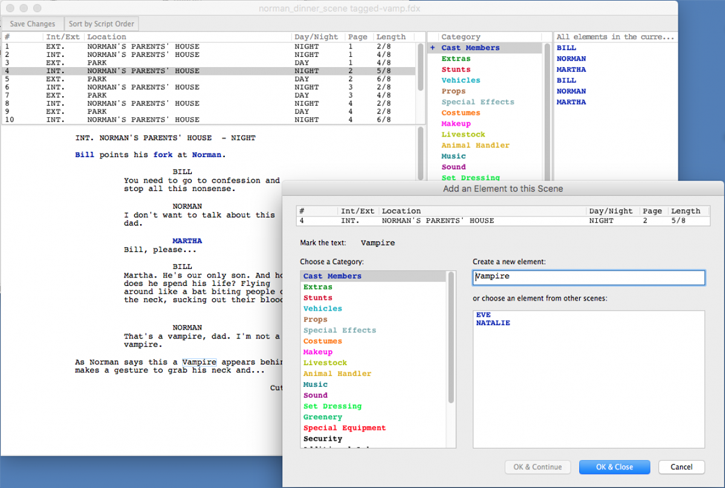Tagging a screenplay is the process of going through the script line by line and highlighting (the old method) all the elements needed for production.
Production Managers would take a physical copy of the script and a set of highlighters. They would go through the script page by page and highlight anything that needs to be present in the scene. Different colors would be used to indicate a different category, and every Production Manager would have their own methodology in terms of colors. It was, by all accounts, the ‘Wild West Way’ of Breaking Down a Script.

Of course, times eventually changed and in the age of word processors, and in particular screenplay programs, things finally (albeit it took a very, very, long time) changed. There are still many veteran Production Managers that like to physically go through the script, page by page, and break it down manually. It’s still a great idea — as you can also write notes on the script — but eventually the pages will get worn-out, and the scribble marks scratching out other scribble marks will probably drive you insane.

Final Draft Tagger comes with Final Draft 10 (If you are using Final Draft 11, see our post on How to Tag Your Screenplay Using Final Draft 11).
You can import your screenplay into it and then go through each scene and “tag” elements.
One of the nice features of Tagger, is that once you import your screenplay into it, it automatically goes through the script and tags all your Characters.

Above you can see that the characters BARNEY and AMANDA are highlighted in blue. This is something that Tagger did automatically upon importing the screenplay. Tagger knew that they were Characters because they have dialogue. And that is another very important thing to remember — only Characters that have dialogue will be automatically tagged.
However, it is possible to tag a Character that does not have dialogue.

In the scene above, there is a Vampire that needs to be in the Scene. However, Final Draft would not automatically tag that Character because the Character does not have a speaking part.
Highlight the Vampire in the scene, then right-click and select the Category “Cast Members”. Vampire will appear in the Cast Members section.

Aside from Characters, you also want to begin tagging ELEMENTS such as Props and Costumes. Common Categories, such as PROPS, COSTUMES, SET DRESSING, MAKEUP, etc., were added so that the Production Manager could easily attach an element to a Category.
You an select a single piece of text in the document or a text string, then right-click the text and select what is called a Category to attach that element to.
Common Categories, such as PROPS, COSTUMES, SET DRESSING, MAKEUP, etc., were added so that the Production Manager could easily attach an element to a Category.

In the above screenshot the prop SPOON is selected, and then added to the PROPS Category.
You can also see the rest of the Categories here, all color-coded. Categories such as Cast Members, Extras, Stunts, Vehicles, Special Effects, Costumes, Makeup, etc.
So, you’ve tagged your screenplay — now what??.
The whole point of tagging your screenplay is so that you can prepare for production. The next thing to do is to import the tagged screenplay into a Film Scheduling program, such as Gorilla Scheduling.
Gorilla Scheduling integrates nicely with Final Draft and Final Draft Tagger. All your tagged elements, such as Props, Costumes, Set Dressing, etc., will automatically be attached to scenes in Gorilla Scheduling.
You can also tag directly into Gorilla Scheduling! — essentially not using Tagger at all.
For a complete working demo of Gorilla Scheduling click here for Macintosh or here for Windows.